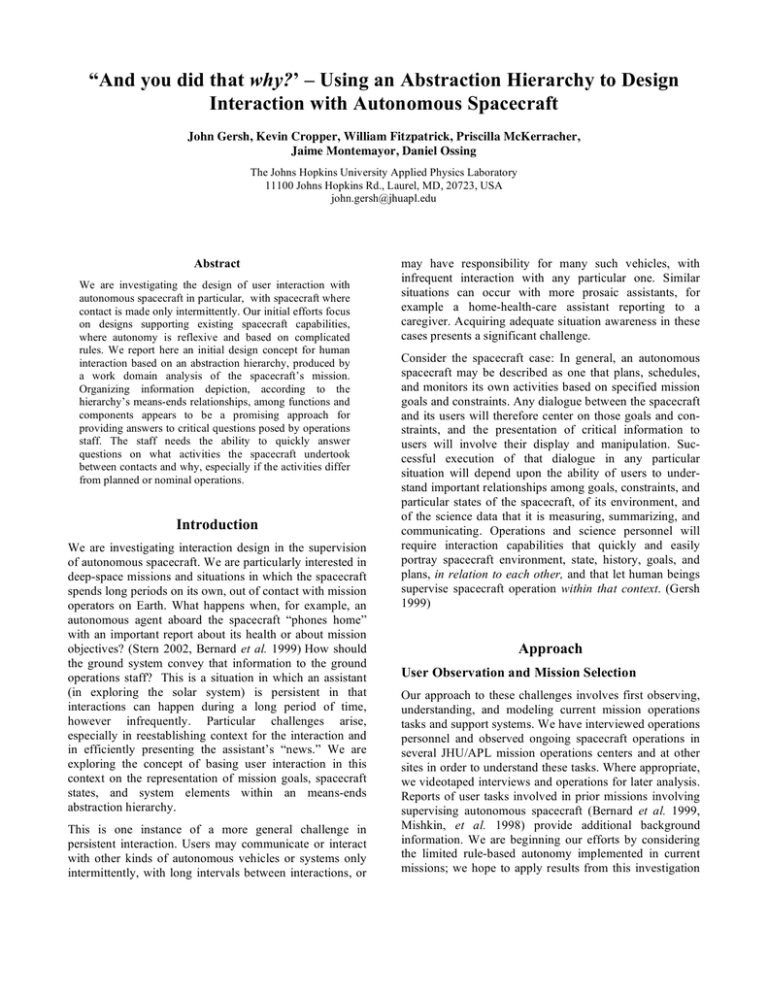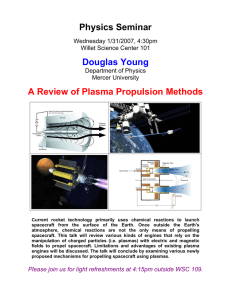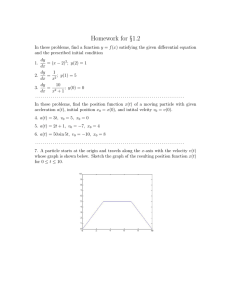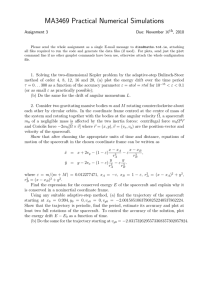why? Interaction with Autonomous Spacecraft
advertisement

“And you did that why?’ – Using an Abstraction Hierarchy to Design Interaction with Autonomous Spacecraft John Gersh, Kevin Cropper, William Fitzpatrick, Priscilla McKerracher, Jaime Montemayor, Daniel Ossing The Johns Hopkins University Applied Physics Laboratory 11100 Johns Hopkins Rd., Laurel, MD, 20723, USA john.gersh@jhuapl.edu Abstract We are investigating the design of user interaction with autonomous spacecraft in particular, with spacecraft where contact is made only intermittently. Our initial efforts focus on designs supporting existing spacecraft capabilities, where autonomy is reflexive and based on complicated rules. We report here an initial design concept for human interaction based on an abstraction hierarchy, produced by a work domain analysis of the spacecraft’s mission. Organizing information depiction, according to the hierarchy’s means-ends relationships, among functions and components appears to be a promising approach for providing answers to critical questions posed by operations staff. The staff needs the ability to quickly answer questions on what activities the spacecraft undertook between contacts and why, especially if the activities differ from planned or nominal operations. Introduction We are investigating interaction design in the supervision of autonomous spacecraft. We are particularly interested in deep-space missions and situations in which the spacecraft spends long periods on its own, out of contact with mission operators on Earth. What happens when, for example, an autonomous agent aboard the spacecraft “phones home” with an important report about its health or about mission objectives? (Stern 2002, Bernard et al. 1999) How should the ground system convey that information to the ground operations staff? This is a situation in which an assistant (in exploring the solar system) is persistent in that interactions can happen during a long period of time, however infrequently. Particular challenges arise, especially in reestablishing context for the interaction and in efficiently presenting the assistant’s “news.” We are exploring the concept of basing user interaction in this context on the representation of mission goals, spacecraft states, and system elements within an means-ends abstraction hierarchy. This is one instance of a more general challenge in persistent interaction. Users may communicate or interact with other kinds of autonomous vehicles or systems only intermittently, with long intervals between interactions, or may have responsibility for many such vehicles, with infrequent interaction with any particular one. Similar situations can occur with more prosaic assistants, for example a home-health-care assistant reporting to a caregiver. Acquiring adequate situation awareness in these cases presents a significant challenge. Consider the spacecraft case: In general, an autonomous spacecraft may be described as one that plans, schedules, and monitors its own activities based on specified mission goals and constraints. Any dialogue between the spacecraft and its users will therefore center on those goals and constraints, and the presentation of critical information to users will involve their display and manipulation. Successful execution of that dialogue in any particular situation will depend upon the ability of users to understand important relationships among goals, constraints, and particular states of the spacecraft, of its environment, and of the science data that it is measuring, summarizing, and communicating. Operations and science personnel will require interaction capabilities that quickly and easily portray spacecraft environment, state, history, goals, and plans, in relation to each other, and that let human beings supervise spacecraft operation within that context. (Gersh 1999) Approach User Observation and Mission Selection Our approach to these challenges involves first observing, understanding, and modeling current mission operations tasks and support systems. We have interviewed operations personnel and observed ongoing spacecraft operations in several JHU/APL mission operations centers and at other sites in order to understand these tasks. Where appropriate, we videotaped interviews and operations for later analysis. Reports of user tasks involved in prior missions involving supervising autonomous spacecraft (Bernard et al. 1999, Mishkin, et al. 1998) provide additional background information. We are beginning our efforts by considering the limited rule-based autonomy implemented in current missions; we hope to apply results from this investigation Figure 1: STEREO Mission Abstraction Hierarchy to systems with more complex autonomy involving onboard planning and scheduling. The current effort uses JHU/APL’s upcoming STEREO solar-observation mission as the source of information and, ultimately, real-time data for driving a functional prototype. Cognitive Work Analysis We performed a cognitive work analysis (Vicente 1999) in order to understand the work environment of mission operations personnel. This method has been used in successful analyses of workers’ interaction with complex process-control systems, and has recently been applied to large-scale command and control and operations systems. (Naikar et al. 2002, Potter et al. 2002, Bisantz et al. 2003). The process involves the use of an appropriate abstraction hierarchy. (Rasmussen 1986) Recent work has indicated as well the utility of defining situations psychologically in terms of such an abstraction hierarchy. (Flach et al. in press) Other kinds of means-ends hierarchies also show promise in presenting information needed for supervision of autonomy. (Hollnagel, in press) We prepared a work domain analysis (WDA) of mission operations for JHU/APL’s upcoming STEREO solar- observation mission. While the primary product of a WDA is a matrix that relates means-ends abstraction decomposition to part-whole system decomposition, we focus here on the abstraction hierarchy. Figure 1 shows the abstraction hierarchy developed in that analysis. (The diagram is folded to fit on the page; the upper portion of the figure is the left part of the diagram, the lower is the right.) It shows overall mission goals in the top level and spacecraft components at the bottom, with intermediate layers of abstraction (more abstract going up) in between. Lines indicate dependencies across levels. The boxed elements appear in the discussion below of our prototype user interaction design. The objective of the two-spacecraft mission is to gather science data and stereoscopic images of the sun, in particular concerning coronal mass ejections (CME). The utility of a representation like this in interacting with an autonomous assistant comes from the means-ends nature of the hierarchy. Looking through connections upward from an element helps answer questions about why that function is being performed or why a system element is present. Looking downward helps answer questions about how a function is being performed. We hypothesize that linking information depiction to this means-ends decomposition will support more effective interaction between mission controllers and their science-datacollecting assistant. Situation awareness in this context depends on understanding why something happened or is planned and how it did or will take place (Flach, et al. in press). User Interaction Design Figure 2 shows an initial design concept for depicting spacecraft situation information organized according to this hierarchy. A task timeline extends across the top of the display; rectangles indicate communication periods. Now is in the center, the past on the left, the future (with planned events) on the right. The lower part of the display shows information about the state of various spacecraft systems, organized according to elements of the abstraction hierarchy. For example, the right-hand portion deals with maintaining a stable attitude, further divided into areas dealing with determining body rates and exercising the control capacity. The vertical orange line in the upper timeline shows the time and type of an autonomous action taken by the spacecraft, implemented in STEREO through a rule-based system. Selecting that action will center time-based display elements on that time and reconfigure the display to show additional detail in the functional areas associated with that action. In the example of Figure 2, an autonomy rule fired because the star tracker (S.T. in the figure) lost track. This situation was brought about by a failure to update the spacecraft’s ephemeris at the scheduled time (a data file containing spacecraft position and motion parameters) on a previous communications contact. The stale ephemeris data led to the spacecraft’s maintaining an incorrect attitude and consequent loss of guide stars. In this situation, connections in the abstraction hierarchy were followed (in concept) to determine which parts of the Figure 2: User Interaction Concept user interface to highlight and to show in greater detail than usual. A key feature of this approach involved connecting and highlighting the depiction of the ephemeris, a data file, to that of the guidance, navigation, and control computer (GNC), within the body rates (upper) section of the stable attitude area on the right. A simple system mimic diagram might not have connected a data file to a physical system component in this way. Evaluation We have shown this prototype design to an experienced mission controller using paper prototyping techniques, with generally positive results. In particular, the controller’s pleased response to the highlighting and contextual expansion (in size and detail) of areas of the interface in response to events or requests as driven by the means-ends abstraction hierarchy was heartening. We have presented the design to other mission operations personnel with similarly positive response to the functional organization principle that it demonstrates. Interestingly, the operators commented particularly positively on the timeline-based connection of past and planned events to the functional depiction. Finding out why something happened while the spacecraft was out of touch can be vital activity. Since one of our overall objectives is to support infrequent interaction between people and autonomous assistants, this will be important in further design iterations. Project Status We are in the process of implementing a limitedfunctionality prototype of this design to run on STEREO telemetry data. The STEREO spacecraft are now in an integration and test phase, in preparation for a January, 2006 launch. We will use simulation and test data from this phase for this initial prototype, with plans for connecting to actual telemetry after launch, if possible. References Bernard, D., Dorais, G., Gamble, E., Kanefsky, B., Kurien, J., Man, G., Millar, W., Muscettola, N., Nayak, P. Rajan, K., Rouquette, N., Smith, B. Taylor, W., Tung, Y. 1999. “Spacecraft Autonomy Flight Experience: The DS1 Flight Agent Experience,” In Proceedings of the AIAA Space Technology Conference and Exposition, Albuquerque, NM: American Institute for Aeronautics and Astronautics. Bisantz, A., Roth, E., Brockman, B., Gisbee, L., Hettinger, L., McKinney, J. 2003. “Integrating cognitive analyses in a large-scale system design process,” Int. J. HumanComputer Studies 58:177-206. Flach, J,. Mulder, M., van Passan, J. 2005. “The Concept of the Situation in Psychology,” in A Cognitive Approach to Situation Awareness: Theory and Application. Forthcoming Gersh, J. 1999. “Get me my agent!” Concepts in Human Interaction with Autonomous Spacecraft, In Proceedings of the AIAA Space Technology Conference and Exposition, Albuquerque, NM: American Institute for Aeronautics and Astronautics. Hollnagel, E. 2005. “Cognition as control: A pragmatic approach to the modeling of joint cognitive systems,” IEEE Transactions on Systems, Man, and Cybernetics. Mishkin, A., Morrison, J., Nguyen, T., Stone, H., Cooper, B., Wilcox, B. 1998. Experience with Operations and Autonomy of the Mars Pathfinder Microrover, In Proceedings of the IEEE Aerospace Conference, v2 pp. 337 -351. Naikar, N., Lintern, G., Sanderson, P. 2002. “Cognitive Work Analysis for Air Defense Applications in Australia,” in Cognitive Systems Engineering in Military Aviation Environments: Avoiding Cogminutia Fragmentosa!, US DoD Human Systems Information Analysis Center State of the Art Report, pp. 169-200. Potter, S., Elm, W., Roth, E., Gualtieri, J. 2002. “Using Intermediate Design Artifacts to Bridge the Gap Between Cognitive Analysis and Cognitive Engineering,” in Cognitive Systems Engineering in Military Aviation Environments: Avoiding Cogminutia Fragmentosa!, US DoD Human Systems Information Analysis Center State of the Art Report, pp. 137-168. Rasmussen, J. 1986. Information Processing and HumanMachine Interaction: An approach to Cognitive Engineering, North-Holland. Stern, S. 2002 “Journey to the Farthest Planet,” Scientific American, May, 2002, pp. 56-63. Vicente, K. 1999. Cognitive Work Analysis, Lawrence Erlbaum.



